
A pub is in several countries a drinking establishment licensed to serve alcoholic drinks for consumption on the premises. The term first appeared in England in the late 17th century, to differentiate private houses from those open to the public as alehouses, taverns and inns. Today, there is no strict definition, but the Campaign for Real Ale (CAMRA) states a pub has four characteristics:
- is open to the public without membership or residency
- serves draught beer or cider without requiring food be consumed
- has at least one indoor area not laid out for meals
- allows drinks to be bought at a bar
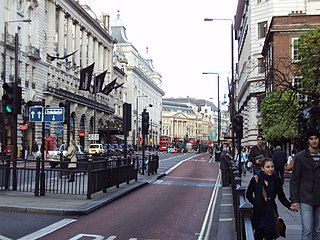
Piccadilly is a road in the City of Westminster, London, England, to the south of Mayfair, between Hyde Park Corner in the west and Piccadilly Circus in the east. It is part of the A4 road that connects central London to Hammersmith, Earl's Court, Heathrow Airport and the M4 motorway westward. St James's is to the south of the eastern section, while the western section is built up only on the northern side. Piccadilly is just under 1 mile (1.6 km) in length, and it is one of the widest and straightest streets in central London.

A tavern is a type of business where people gather to drink alcoholic beverages and be served food such as different types of roast meats and cheese, and where travelers would receive lodging. An inn is a tavern that has a license to put up guests as lodgers. The word derives from the Latin taberna whose original meaning was a shed, workshop, stall, or pub.

The Angel, Islington, is a historic landmark and a series of buildings that have stood on the corner of Islington High Street and Pentonville Road in Islington, London, England. The land originally belonged to the Clerkenwell Priory and has had various properties built on it since the 16th century. An inn on the site was called the "Angel Inn" by 1614, and the crossing became generally known as "the Angel". The site was bisected by the New Road, which opened in 1756, and properties on the site have been rebuilt several times up to the 20th century. The corner site gave its name to Angel tube station, opened in 1901, and the surrounding Angel area of London.

Pub names are used to identify and differentiate traditional drinking establishments. Many pubs are centuries old, and were named at a time when most of their customers were illiterate, but could recognise pub signs. The use of signage was not confined to drinking establishments. British pubs may be named after and depict anything from everyday objects, to sovereigns, aristocrats and landowners. Other names come from historic events, livery companies, occupations, sports, and craftsmen's guilds. One of the most common pub names is the Red Lion. This list contains both modern and historical examples.
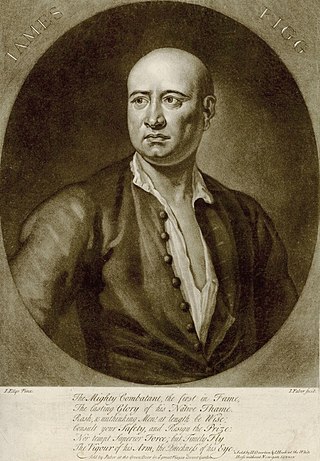
James Figg was an English prizefighter and instructor in historical European martial arts. While Figg primarily fought with weapons including short swords, quarterstaffs, and cudgels, he also played a role in boxing's development. In 1719, he opened a London fighting venue that could seat more than 1,000 spectators and was one of the first of its kind. In 1725, he organised and promoted modern history's first international boxing match at his amphitheatre. He claimed to have won more than 200 matches during his career, and was posthumously considered the first boxing champion.
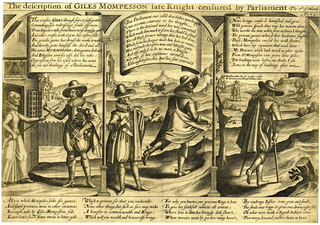
Giles Mompesson was an English office holder and courtier who sat in the House of Commons between 1614 and 1621, when he was sentenced for corruption. He was officially a "notorious criminal" whose career was based on speculation and corruption. His name came to be regarded as a synonym for official corruption, because he used nepotism to gain positions for licensing businesses by which he pocketed the fees. In the reaction against Charles I, Mompesson's name was invoked as a symbol of all that was wrong with aristocracy. Sir Giles Overreach, the anti-hero of Philip Massinger's 1625 play A New Way to Pay Old Debts, is based on Mompesson.

The Boar's Head Inn is the name of several former and current taverns in London, most famously a tavern in Eastcheap that is supposedly the meeting place of Sir John Falstaff, Prince Hal and other characters in Shakespeare's Henry IV plays. An earlier tavern in Southwark used the same name, and an inn of the name in Whitechapel was used as a theatre.

The Old Talbott Tavern, also known as the Old Stone Tavern, a historic tavern built in 1779, is located in the Bardstown Historic District of Bardstown, Kentucky, across from the historic Nelson County Courthouse. It was placed on the National Register of Historic Places on October 30, 1973.

Walsoken is a settlement and civil parish in Norfolk, England, which is conjoined as a suburb at the northeast of the town of Wisbech, Isle of Ely, Cambridgeshire.
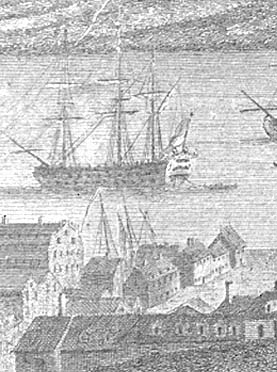
The Great Pontack was a large three-story building, erected by the Hon. John Butler, previous to 1754, at the corner of Duke and Water Streets in Halifax, Nova Scotia. It was named after the famous Pontack Club in London. The first resident professional company in Canada was The American Company of Comedians, believed to have performed at The Great Pontack, Halifax, in the summer and fall of 1768.

Gray's Ferry Tavern was a restaurant and inn that operated in the 18th and 19th centuries in present-day Philadelphia, Pennsylvania. Set on the west bank of the Schuylkill River at the primary crossing for travel to and from points south of Philadelphia, the tavern hosted George Washington and many other famous people of its day.
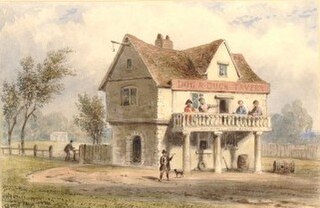
The Dog and Duck was a tavern built upon St George's Fields in London in the 17th century. It was named after the sport of duck-baiting, that took place in adjacent wetland. In the 18th century its gardens were used as a spa but, by the 1770s, with spas no longer fashionable, it declined into a rowdy location for concerts. The magistrates refused to renew its licence, despite protracted legal disputes, and it closed in 1799. The building was then used as a School for the Indigent Blind and demolished in 1812, when the new Bethlem Hospital was built upon the site. That building is now used by the Imperial War Museum.

The Old White Horse Cellar at No. 155 Piccadilly was one of the best-known coaching inns in England during the 18th and 19th centuries. The first mention of the White Horse Cellar is in 1720. It was originally located on the corner of Arlington Street, where the Ritz Hotel is now located. The first landlord, a man named Williams, named it in honor of the newly established House of Hanover, whose heraldic emblem featured a white horse. The White Horse rose to prominence under Abraham Hatchett who later moved it to the opposite side of the road on the corner of Albemarle Street, where it was known as "Hatchett’s Hotel and White Horse Cellar". The precise date of the move is not known, but was precipitated by the construction of the Bath Hotel, which was located on the corner of Piccadilly and Arlington as early as 1798. It was torn down in 1884 to make room for the Albemarle.

The Mitre Inn is a public house at 58 High Street, Chipping Barnet, London. It was established by 1633 and is probably the oldest remaining of the town's once numerous coaching inns. It is a grade II listed building with Historic England and is currently styled "Ye Olde Mitre Inne".
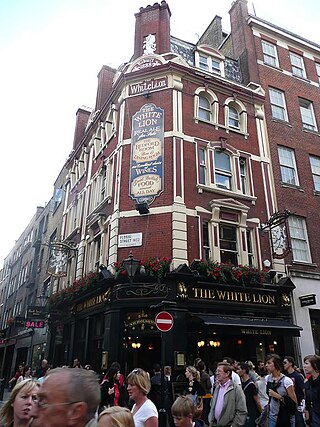
The White Lion is a pub in Covent Garden, London, on the corner of James Street and Floral Street.

The Boar's Head Inn was a tavern in Eastcheap in the City of London which is supposed to be the meeting place of Sir John Falstaff, Prince Hal and other characters in Shakespeare's Henry IV plays.

The Edgar Wallace is a public house at 40–41 Essex Street, London WC2, at the corner with Devereux Court.

Blossom's Inn was a tavern which stood in Lawrence Lane in the City of London from the 14th century until 1855. It became a substantial coaching inn and was used as a staging post by carriers of goods. In the 19th century, the lease was bought and it became the parcel depot of the Great Eastern Railway. Its name was used for a major property development at the end of the 20th century and the site is now part of the large complex of 30 Gresham Street.

The Chalk Farm Tavern was a public house located in what is today Regent's Park Road in Primrose Hill, London.



















